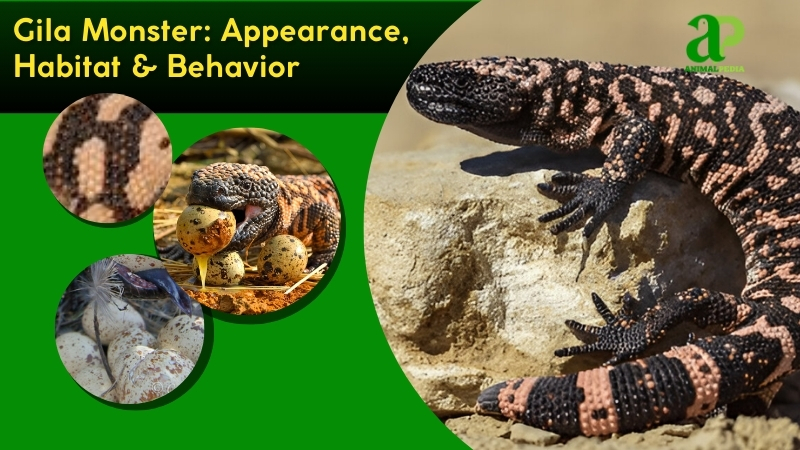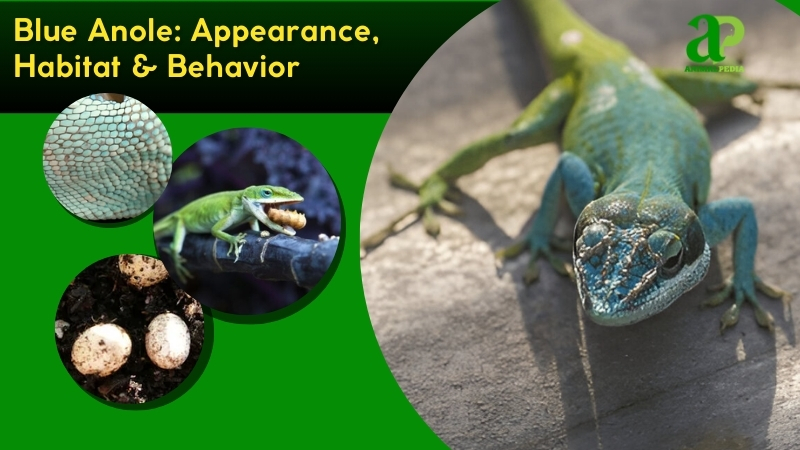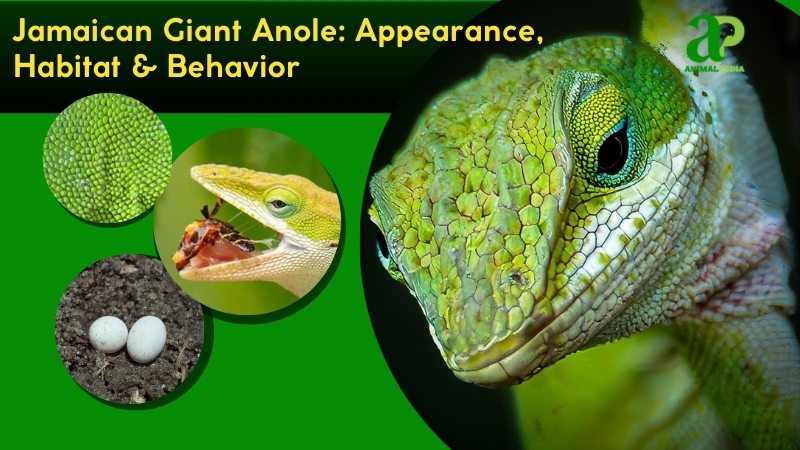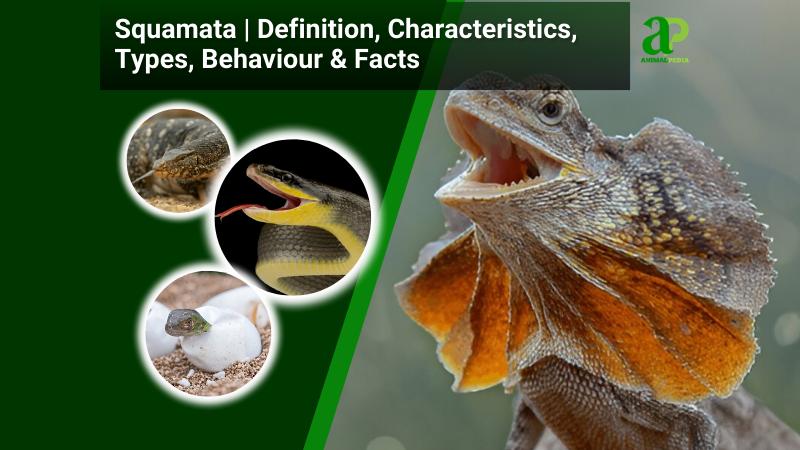Crocodile Monitors are magnificent reptiles belonging to the species Varanus salvadorii, found exclusively in the lowland and mid-montane rainforests of Papua New Guinea and nearby islands. Also known as Salvadori’s monitor or Papua monitor, these impressive lizards are among the longest in the world, with adults typically reaching 8-9 feet (2.4-2.7 meters) in length and weighing 20-40 pounds (9-18 kg). Their slender build, tail length, and distinctive appearance have made them a subject of fascination for herpetologists and wildlife enthusiasts alike.
Distinguished by their elongated body structure, Crocodile Monitors possess a whip-like tail that makes up over two-thirds of their total length—a unique adaptation that functions as a prehensile fifth limb for climbing. Their dark green to black coloration, adorned with vivid yellow spots or bands that fade with age, provides excellent camouflage in their dense rainforest habitat. With long, powerful limbs ending in curved claws and a narrow, elongated head equipped with sharp teeth, these monitors are perfectly adapted for their arboreal lifestyle.
As apex predators, Crocodile Monitors demonstrate hunting abilities, primarily targeting birds, small mammals, and other reptiles while also scavenging when opportunities arise. Their behavior shifts with seasonal changes—becoming more active during the wet season (November-April) when prey is abundant, and reducing movement during the drier months (May-October) to conserve energy.
Despite not being classified as endangered, these impressive reptiles face threats from habitat destruction, hunting for their skin, and capture for the exotic pet trade. Their elusive nature in the wild has made them one of the least-studied large monitor species, adding to their mystery and appeal.
In this article, we’ll explore the fascinating world of Crocodile Monitors, examining their unique physical characteristics, rainforest habitat, and behavioral adaptations.
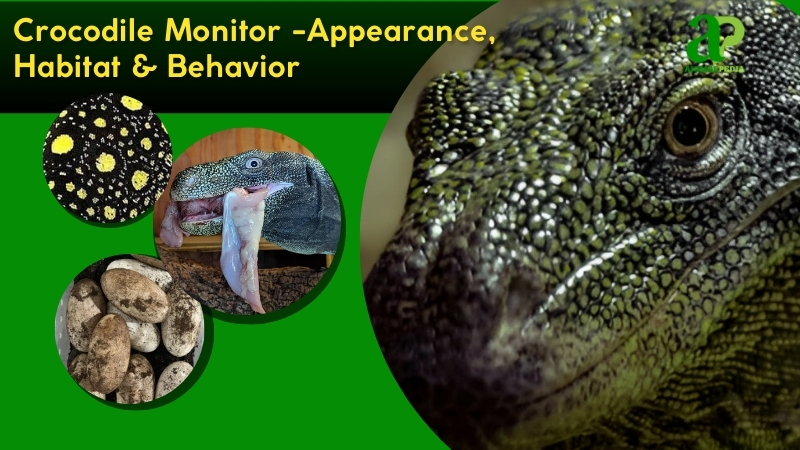
What does the Crocodile Monitor look like?
The crocodile monitor, one of the longest lizards, boasts a slender, whip-like body stretching 8–13 feet (2.4–4 meters) on average, though some reach 16 feet (5 meters). Weighing 20–40 pounds (9–18 kg), it’s lighter than bulkier monitors. Its color is a striking mix of dark green to black, adorned with vivid yellow spots or bands that fade with age, creating a speckled pattern. The skin is tough yet flexible, covered in small, bead-like scales with a slightly glossy texture, unlike the rougher, osteoderm-heavy hides of other monitors.
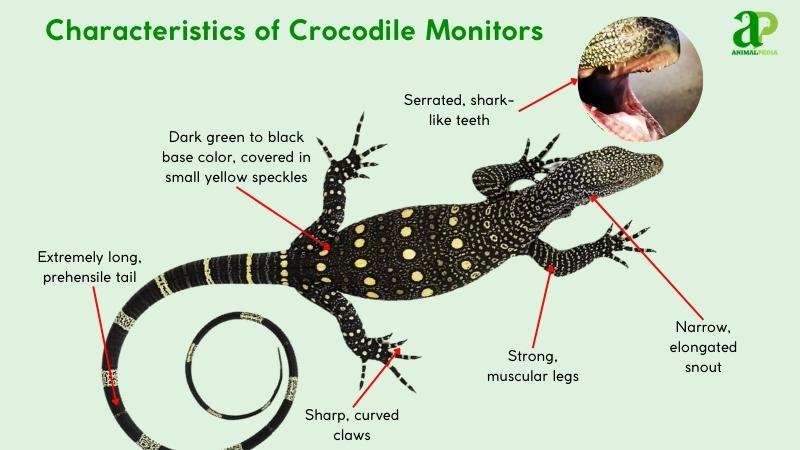
Starting with its narrow, elongated head, the crocodile monitor has sharp, piercing eyes with excellent vision. Its long, forked tongue, pinkish-purple, flicks to sense prey. The neck is exceptionally long and sinuous, blending into a lean, muscular body. Its powerful limbs, equipped with 2-inch (5 cm) curved claws, excel at climbing trees, a rarity among large monitors. The tail, prehensile and whip-like, spans over two-thirds of its length, aiding balance and grip.
Compared to the characteristic Komodo Dragon (Varanus komodoensis), the crocodile monitor is slimmer, arboreal, and lacks the Komodo’s toxic bite. Against the Nile monitor (Varanus niloticus), its longer tail and vibrant yellow markings stand out, as does its preference for forested habitats over the Nile’s aquatic tendencies. The crocodile monitor’s lightweight build and arboreal agility make it unique among varanids.
How big do Crocodile Monitors get?
The crocodile monitor averages 8–9 feet (2.4–2.7 meters) in length and weighs 20–40 pounds (9–18 kg). These arboreal lizards, native to New Guinea, vary in size by region.
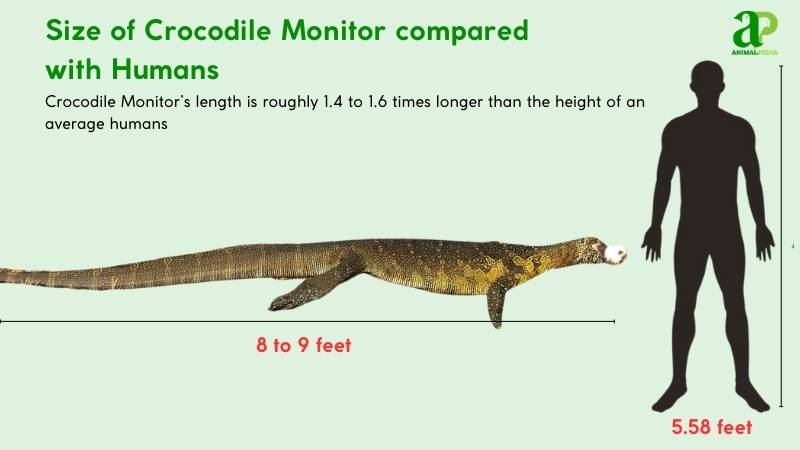
The longest recorded specimen reached 10.6 feet (3.23 meters), captured in Konedobu, Papua New Guinea, documented by Dr. F. Barker, though some unverified claims suggest lengths up to 15.6 feet (4.75 meters). Weight data for the heaviest is less precise, but estimates hover around 44 pounds (20 kg) for exceptional individuals, based on Smithsonian records.
Adult crocodile monitors typically reach 8–10 feet (2.4–3 meters) snout-to-tail, with tails comprising two-thirds of their length. Males are notably larger and heavier than females, often exceeding them by 1–2 feet (0.3–0.6 meters) and 10–15 pounds (4.5–6.8 kg). This sexual dimorphism reflects males’ robust heads and broader builds. See the table below for key differences.
| Trait | Male | Female |
| Length (ft/m) | 9–10 (2.7–3) | 7–8 (2.1–2.4) |
| Weight (lb/kg) | 30–44 (13.6–20) | 20–30 (9–13.6) |
What are the unique physical characteristics of Crocodile Monitors?
The Crocodile Monitor has a uniquely long, prehensile tail, which makes up over two-thirds of its body length and often reaches 6–10 feet (1.8–3 meters). Unlike other monitors that use tails mainly for balance or swimming, the crocodile monitor’s tail functions as a powerful gripping tool for tree climbing, making it the most arboreal of large varanids.
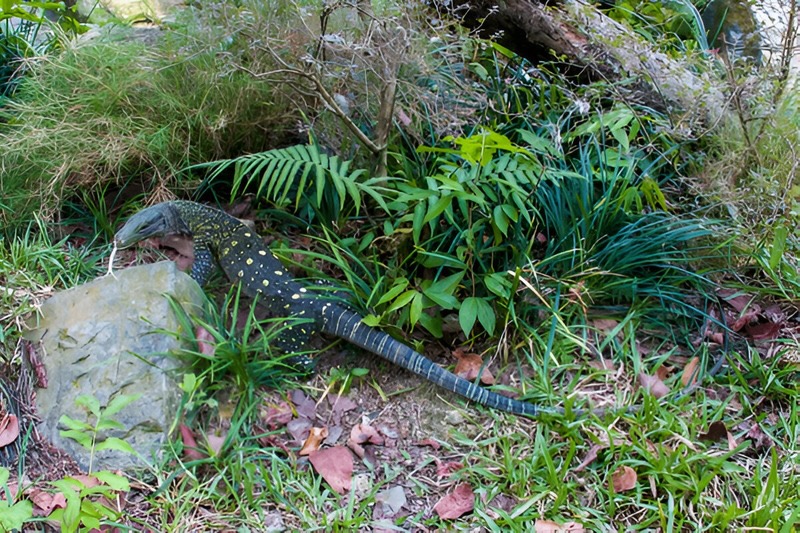
A 2021 study in the Journal of Herpetology revealed that its tail is reinforced with elongated vertebrae and dense muscles, providing a grip strength of 15–20 psi (103–138 kPa). This adaptation helps it move through New Guinea’s dense rainforests with ease. Research by Dr. Mark Auliya highlights its advanced neuro-muscular coordination, allowing precise movements—unlike the stiffer, less flexible tails of terrestrial monitors. This specialized trait supports its role as an agile, canopy-dwelling predator.
Anatomy
The Crocodile Monitor is a highly agile, arboreal predator with specialized adaptations for its rainforest environment.
- Respiratory System: Possesses large, multi-chambered lungs that support sustained climbing and bursts of speed. Oxygen exchange occurs efficiently in alveoli, aiding endurance and ambush predation.
- Circulatory System: Features a nearly four-chambered heart with partial ventricular separation, enabling efficient oxygen delivery. This supports its active, arboreal lifestyle and rapid, high-energy movements.
- Digestive System: Equipped with an expandable stomach and strong gastric acids to process birds, mammals, and carrion. Unlike Komodo dragons, it lacks venom but compensates with serrated teeth that inflict deep wounds.
- Excretory System: Its kidneys produce uric acid, reducing water loss—an adaptation to humid yet freshwater-dependent rainforest habitats.
- Nervous System: A highly developed brain and sensory system aid hunting. Its forked tongue and Jacobson’s organ detect chemical cues from prey or carrion, while large eyes provide keen vision for navigating dense foliage.
These attributes combine to make the Crocodile Monitor a standout among monitor lizards, showcasing a fascinating and majestic species in its natural environment.
Where do Crocodile Monitors live?
The Crocodile Monitor is endemic to the lowland and mid-montane rainforests of Papua New Guinea, particularly along the southern coast and in river valleys, including the Fly, Strickland, and Kikori River basins. It is also found on nearby islands, such as the Aru Islands, but is absent from northern New Guinea.
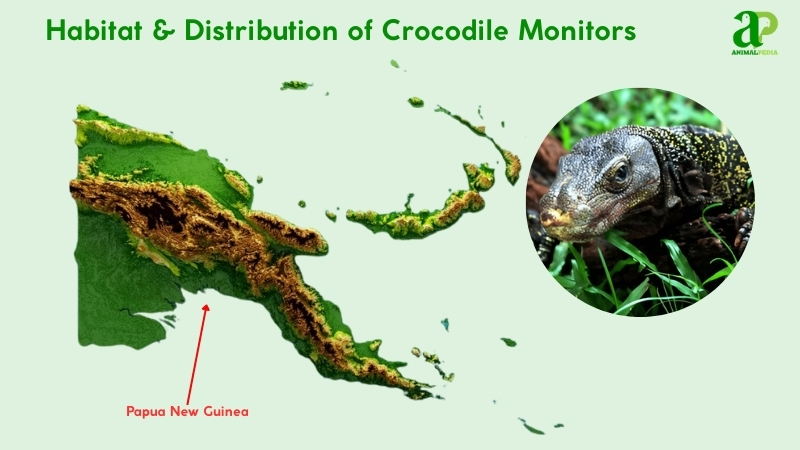
These regions support dense, humid forests with abundant trees, which are essential to their arboreal lifestyle. High temperatures, consistent rainfall, and ample prey—including birds, mammals, and reptiles—support its survival. The prehensile tail, sharp claws, and long limbs are specialized for climbing and maneuvering in thick canopies.
Fossil and molecular studies suggest the Crocodile Monitor has inhabited New Guinea for millions of years, evolving in isolation. No evidence of migration has been found, as the species is highly adapted to rainforest ecosystems.
How do seasonal changes affect their behavior?
The Crocodile Monitor exhibits behavioral changes in response to seasonal variations in its rainforest habitat. Papua New Guinea experiences two primary seasons—wet and dry—which influence the lizard’s activity, hunting strategies, and reproduction.
- Wet Season (November – April)
Increased activity due to abundant prey. Crocodile Monitors hunt more frequently, taking advantage of birds, mammals, and reptiles drawn to seasonal food sources. Higher humidity enhances their arboreal mobility. Breeding occurs, with males becoming more territorial and aggressive.
- Dry Season (May – October)
Reduced activity as prey disperses. More time is spent basking to regulate body temperature. Hunting shifts to ambush tactics, relying on patience rather than pursuit. Juveniles hide in dense foliage to avoid predation.
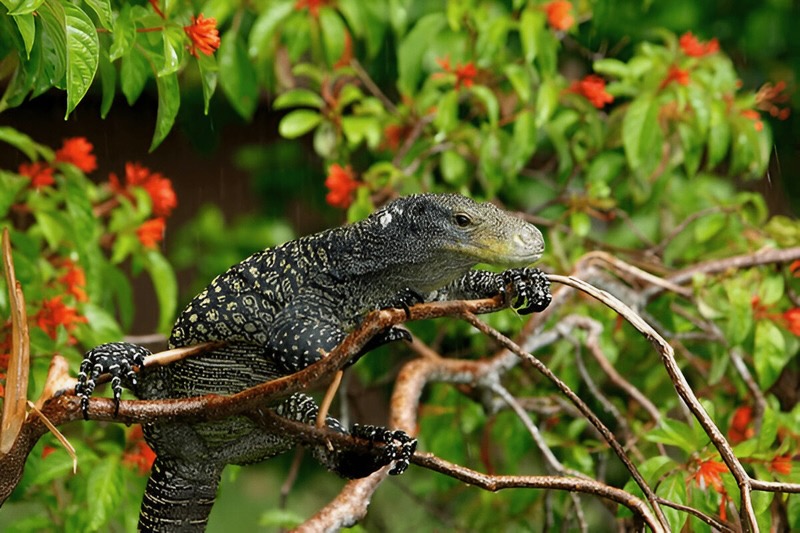
Seasonal shifts in prey availability, thermoregulation, and reproductive behaviors make it a highly adaptable rainforest predator.
How do Crocodile Monitors behave?
Crocodile Monitors are among the most intriguing and elusive reptilian predators, showcasing a combination of agility, intelligence, and lethal hunting abilities.
- Diet: Carnivorous, preying on birds, mammals, and reptiles, while also scavenging carrion. Their serrated teeth and powerful jaws inflict deep wounds.
- Hunting Mechanisms: Skilled arboreal ambushers, using speed and precision to strike prey from tree branches.
- Age-Based Diet: Hatchlings eat insects and small amphibians; juveniles eat rodents and birds; adults hunt larger prey.
- Daily Activity Patterns: Diurnal, basking in the morning and actively hunting in cooler hours.
- Locomotion: Fast climbers and adept swimmers, using long tails for balance and agility.
- Social Behavior: Solitary, with aggressive encounters between males during mating season.
- Communication: Uses body language, scent-marking, and vocalizations such as hissing.
- Threats: Faces habitat destruction, illegal trade, and hunting, leading to population decline.
- Lifespan: Wild individuals live 15–20 years, while captive individuals can live up to 25 years.
Crocodile Monitors are enigmatic and highly specialized predators, showcasing adaptations for survival in one of Earth’s most challenging ecosystems.
What do Crocodile Monitors eat?
Crocodile monitors are carnivorous reptiles that primarily feed on birds, mammals, and carrion. Their long, agile body and sharp teeth make them excellent tree-climbing hunters, capable of ambushing prey from above. While they are skilled predators, scavenging for carcasses also plays a role in their diet. Unlike Komodo dragons, crocodile monitors do not rely on venom but instead use their powerful jaws and sharp teeth to inflict deep wounds that can immobilize prey.

Diet by Age
Crocodile monitors exhibit distinct dietary changes as they grow, adapting their feeding habits to their size and hunting skills.
- Hatchlings (0-1 Year)
Young monitors primarily consume insects, small amphibians, and nestling birds. Their arboreal lifestyle helps them avoid larger predators while allowing them to hunt small, easy-to-capture prey.
- Juveniles (1-3 Years)
As they grow, juveniles begin incorporating small rodents, lizards, and larger insects into their diet. Their hunting skills develop, and they start catching small birds and reptiles while also scavenging for carrion.
- Subadults (3-5 Years)
At this stage, crocodile monitors can take down larger birds, medium-sized mammals (such as rodents and bats), and reptiles. They continue to scavenge opportunistically, taking advantage of any available food source.
- Adults (5+ Years)
Fully grown crocodile monitors become apex arboreal predators, preying on large birds, bats, and small to medium-sized mammals. They are known to raid bird nests and ambush prey from tree branches. Scavenging is also a key part of their feeding strategy, and they will consume any available meat, including carrion.
Diet by Gender
There are no significant dietary differences between male and female crocodile monitors. Both exhibit opportunistic hunting and scavenging behaviors. However, larger individuals—typically males—may be able to tackle larger prey.
Diet by Seasons
Crocodile monitors are year-round hunters and scavengers, showing minimal seasonal variation in diet. Their feeding depends more on prey availability than on specific seasonal changes. During dry seasons, they may rely more on scavenging and preying on birds, while the rainy season may offer more opportunities to hunt amphibians and mammals.
The following infographic highlights the two primary feeding strategies of crocodile monitors: active hunting and opportunistic scavenging.
How do Crocodile Monitors hunt their prey?
Crocodile Monitors are skilled hunters, utilizing their agility and stealth to capture prey in their rainforest habitats. Their long tails and powerful limbs help them move swiftly through dense vegetation, approaching their unsuspecting targets quietly. With sharp claws for gripping branches, Crocodile Monitors navigate the treetops effortlessly.
To hunt, these creatures rely on their sharp eyesight to detect prey from a distance. Once a target is spotted, they stalk with precision, staying close to the ground to avoid detection. When ready, they launch a swift attack, using their strong jaws and sharp teeth to subdue their prey quickly, particularly adept at catching slippery creatures such as birds and small mammals.
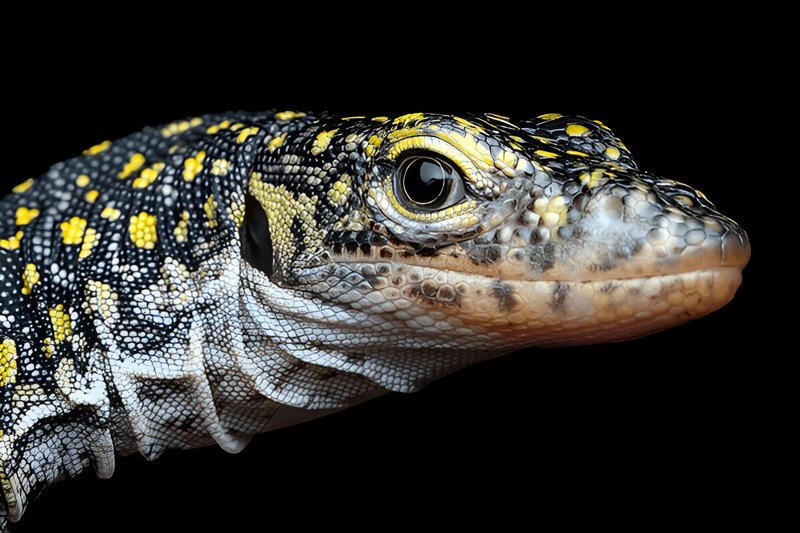
Every hunt for a Crocodile Monitor is a thrilling display of their hunting prowess, showcasing their ability as skilled predators in the wild.
Are Crocodile monitors venomous?
Crocodile Monitors don’t possess venom, making them safe for encounters in their natural habitat. Although their appearance might seem intimidating due to their long bodies and sharp teeth, rest assured that their bites are non-poisonous.
These impressive creatures rely on their incredible speed and agility rather than venom to hunt in the tree canopy of the tropical rainforests where they live. With keen senses of smell and exceptional vision, they locate prey such as small mammals, birds, and eggs with precision.
When are Crocodile Monitors most active during the day?
Crocodile monitors are diurnal reptiles, primarily active during daylight hours. They spend mornings and evenings basking in the sun on elevated platforms or branches, utilizing these periods to warm up and search for prey. As temperatures rise midday, they often descend to drink, swim, and explore their surroundings.
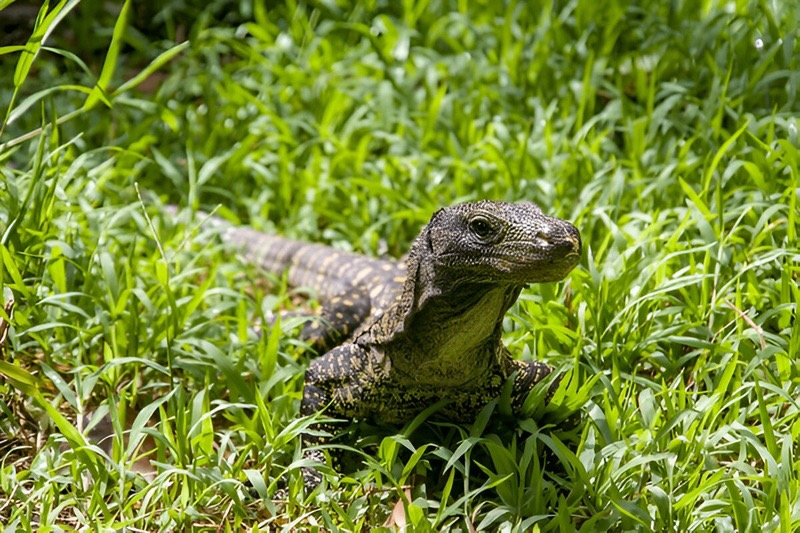
As ectotherms, crocodile monitors rely on external heat sources to regulate their body temperature. They bask in the sun to raise their body temperature and may seek shade or water to cool down when necessary. This behavioral thermoregulation is essential for maintaining optimal physiological functions.
In captivity, enrichment programs that introduce novel items, scent trails, and environmental changes can enhance their activity levels, counteract obesity, and promote exploratory behaviors. Facilities like the Melbourne Zoo and Singapore Zoo have implemented such programs to stimulate natural behaviors in their monitor lizards.
How do Crocodile Monitors move on land and water?
The Crocodile Monitor demonstrates agility both on land and in water. On land, these creatures use their powerful legs to move through forests, walking like a crocodile, using their long bodies and muscular tails for balance. Their movements are fluid and efficient, showcasing speed and precision as they navigate their habitats.
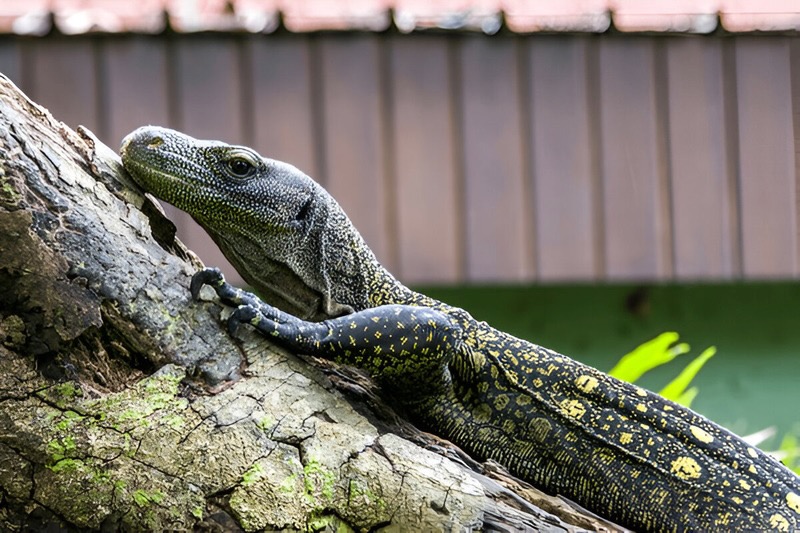
In water, the Crocodile Monitor is equally impressive, being a skilled swimmer that glides gracefully through rivers and streams. Their streamlined bodies and webbed feet are well-suited for aquatic life, allowing them to move effortlessly. Whether diving to catch prey or simply cooling off, these monitors display a natural grace in the water, showcasing their adaptability and agility.
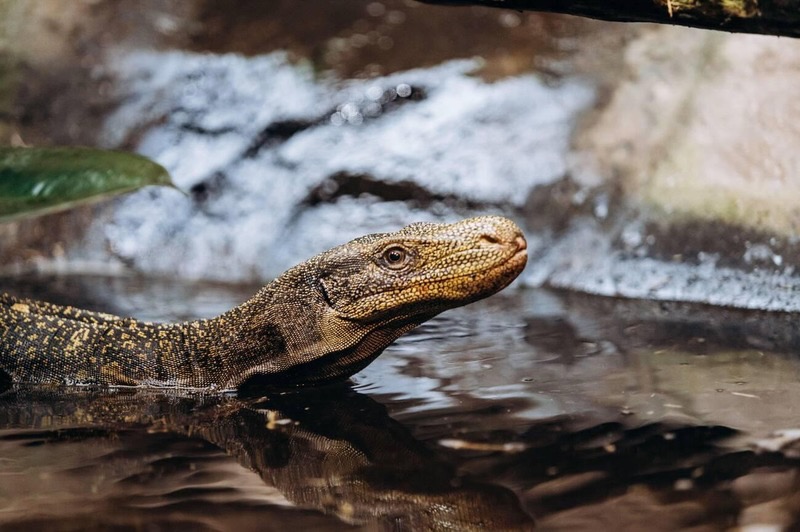
Witnessing the Crocodile Monitor’s movements on land and in water is a mesmerizing experience, highlighting their freedom and grace with every step.
Do Crocodile Monitors live alone or in groups?
Crocodile Monitors are typically solitary animals. These impressive reptiles prefer to live and hunt independently in the lush rainforests they inhabit. Solitude allows them the freedom to explore large territories and search for food without the constraints of group dynamics.
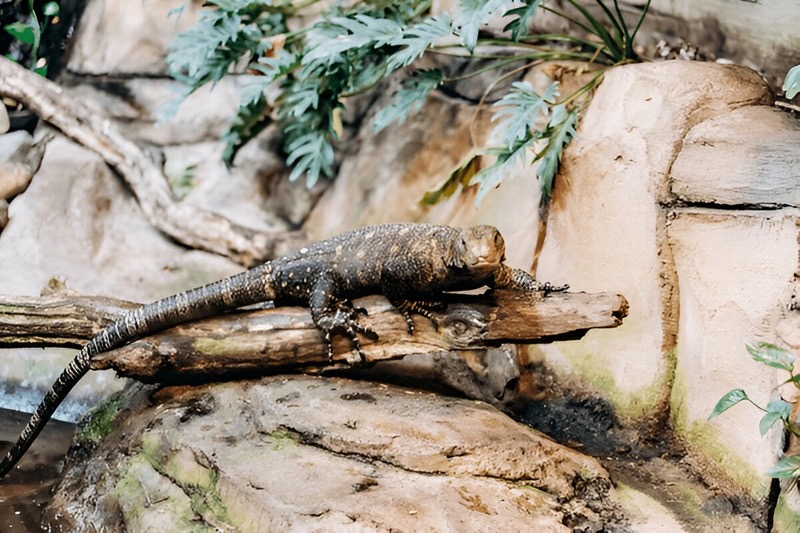
Although they mostly lead solitary lives, Crocodile Monitors aren’t entirely unsociable. They may engage briefly during mating seasons or chance encounters in the wild. However, they generally prefer their own company and don’t tend to form strong social bonds with other monitors.
Their independent nature enables them to thrive in the dense forests of Papua New Guinea, where they can effortlessly navigate both the trees and the forest floor. Being alone suits these majestic creatures, granting them the independence to roam their territory freely, hunt for prey without competition, and truly embody the essence of the wilderness.
How do Crocodile Monitors communicate with each other?
Crocodile Monitors primarily communicate through visual and olfactory signals. These intelligent creatures rely on their keen eyesight to interpret body language and movements, using subtle gestures such as head bobbing and tail flicking to convey messages to one another. In addition to visual cues, they also release pheromones to mark territory and attract potential mates, sharing vital information about their identity and reproductive status in the dense rainforest habitat they inhabit.
Vocalizations are another important aspect of Crocodile Monitor communication. They produce grunts, hisses, and growls to express different emotions such as aggression, fear, or contentment, helping them establish boundaries and warn off dangers in their environment.
This combination of visual, olfactory, and auditory communication methods allows Crocodile Monitors to navigate their social interactions effectively within their rainforest homes.
How do Crocodile Monitors reproduce?
The Crocodile Monitor is oviparous, reproducing through egg-laying. The breeding season occurs during the wet season (November – April) when resources are abundant. Males become highly territorial, engaging in combat, wrestling, and biting, to establish dominance. Courtship involves tongue-flicking, circling, and tail caressing before mating.
After mating, the female lays 4–12 eggs, each weighing approximately 50–60 grams. She selects tree hollows, termite mounds, or burrows for egg deposition, providing insulation and protection. Unlike some reptiles, neither parent guards the nest post-laying.
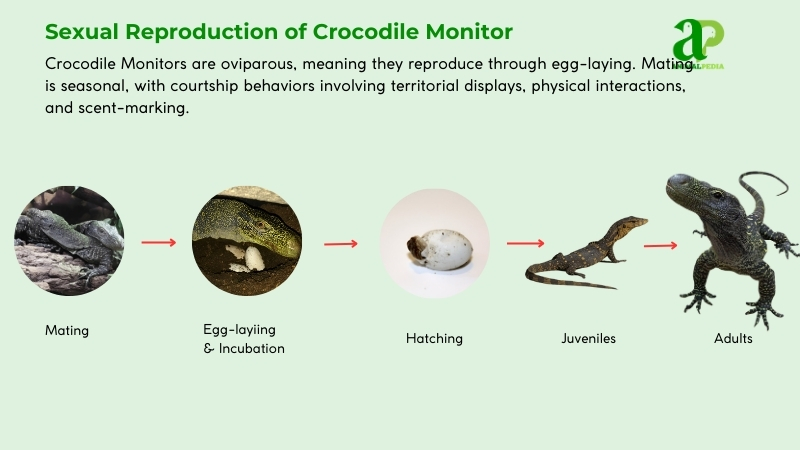
Egg-laying can be disrupted if the female lacks a suitable nesting site, leading to egg retention (dystocia), a fatal condition. This often occurs in captivity, where proper nesting substrates are lacking.
Eggs incubate for 7–9 months, hatching during the early wet season when prey is plentiful. Hatchlings emerge at 35–45 cm (14–18 inches) and grow rapidly, feeding on insects and small vertebrates before transitioning to larger prey.
How long do Crocodile Monitors live?
The Crocodile Monitor has a lifespan of 15–20 years in the wild, with some individuals in captivity exceeding 25 years under optimal care. Males and females have similar lifespans, though males, being larger and more territorial, may face higher risks of injury from combat.
They reach sexual maturity at 3–4 years and continue growing throughout life. Growth rates slow with age, but individuals are active hunters. Captive monitors tend to live longer due to reduced predation and medical care, while wild monitors face threats from habitat loss and hunting.
With proper care and suitable conditions, these impressive lizards can lead long and fulfilling lives, making them captivating to observe in the wild or care for in captivity.
What are the threats or predators that Crocodile Monitor faces today?
Crocodile Monitors face multiple threats, primarily driven by human activities and environmental changes. These factors contribute to population declines, making conservation efforts increasingly important.
- Habitat Destruction: Deforestation for logging, agriculture, and urban expansion reduces essential nesting and hunting grounds. Papua New Guinea’s deforestation rate exceeds 1.4% annually, directly impacting its population.
- Hunting & Illegal Wildlife Trade: Crocodile Monitors are hunted for their skin (leather trade) and captured for the exotic pet market. Demand from collectors threatens wild populations, with illegal trade documented in.
- Human-Wildlife Conflict: Seen as dangerous or pests, these monitors are sometimes killed on sight by local communities. Their fearsome appearance and opportunistic feeding habits on livestock contribute to persecution.
- Climate Change: Altered temperature and rainfall patterns affect prey availability and nesting conditions. Rising temperatures may affect egg incubation and hatchling survival.
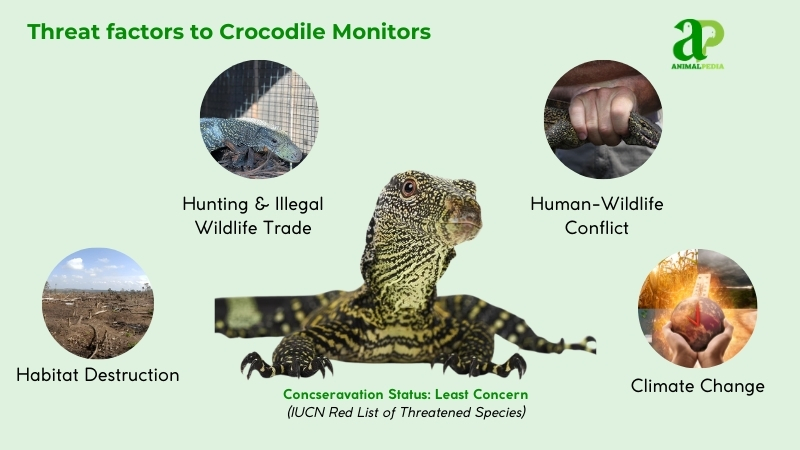
Apart from these environmental and human-related threats, natural predators also pose a challenge, particularly to younger individuals. Large birds of prey, such as eagles and hawks, often hunt juveniles, while large snakes, including pythons, prey on hatchlings and smaller individuals. In some cases, even other monitor lizards may prey on weaker or smaller members of their species, further reducing survival rates.
Are Crocodile Monitors endangered?
The Crocodile Monitor lizard isn’t currently considered endangered despite facing threats in the wild. This striking creature, known for its size and appearance, isn’t at risk of extinction at present. However, challenges in its environment could impact its population in the future.
While the species isn’t endangered currently, it’s crucial to monitor and protect these creatures to ensure their ongoing survival in the wild. Understanding and addressing the threats they face are vital steps in preserving Crocodile Monitors for future generations. By remaining vigilant and working together, we can safeguard the existence of these reptiles.
What conservation efforts are underway?
The Crocodile Monitor Lizard is currently facing threats like habitat loss from deforestation and predation on young individuals. Conservation efforts are crucial to address these challenges.
Organizations are actively working on protecting the lizard’s natural habitat through reforestation projects and land conservation initiatives. By restoring and preserving the forests where these lizards live, we can ensure their continued existence in the wild.
Education programs are also underway to raise awareness about the importance of safeguarding the Crocodile Monitor and its ecosystem. Through these combined efforts, we can help secure the future of this lizard species. Join us in supporting these conservation initiatives to help ensure the survival of the Crocodile Monitor. Together, we can make a difference in preserving these amazing reptiles.
Frequently Asked Questions
What Is the Average Lifespan of a Crocodile Monitor?
On average, a crocodile monitor typically lives 20-30 years. Their long lifespans can provide you with many years of enjoying and caring for this impressive species if you’re considering having one as a pet.
Do Crocodile Monitors Make Good Pets?
Crocodile monitors don’t make good pets. They require specialized care, space, and expertise. Consider adopting a more suitable companion. Research beforehand to guarantee a positive experience for both you and the monitor.
Can Crocodile Monitors Swim?
Yes, Crocodile Monitors can swim. They use their long, powerful tails to glide through water effortlessly. It’s a natural skill for them. So, if you’re around water with one, be prepared for a swift swimmer!
How Fast Can a Crocodile Monitor Run?
Crocodile Monitors can reach speeds of up to 18 mph when sprinting. These speedy lizards may surprise you with their ability to cover ground quickly. Keep your eyes peeled!
Are Crocodile Monitors Endangered?
Yes, Crocodile Monitors are considered vulnerable due to habitat loss and hunting. Their populations are declining, so efforts are being made to protect and conserve these magnificent creatures for future generations to enjoy and study.
Conclusion
The Crocodile Monitor is a fascinating creature with its sleek body, vibrant colors, and unique patterns that aid in camouflage. They are skilled climbers, agile hunters, and excellent communicators in their natural habitat. With their impressive size and keen senses, these creatures are truly a wonder to observe. So next time you find yourself in the dense tropical rainforests of New Guinea, keep an eye out for the magnificent Crocodile Monitor!





